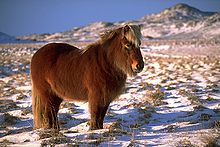 Icelandic horses weigh between 330 and 380 kilograms (730 and 840 lb) and stand an average of 13 and 14 hands (52 to 56 inches, 132 to 142 cm) high, which is often considered pony size, but breeders and breed registries always refer to Icelandics as horses. Several theories have been put forward as to why Icelandics are always called horses, among them the breed's spirited temperament and large personality, and the lack of a word in Icelandic for "pony".Another theory suggests that the breed's weight, bone structure and weight-carrying abilities mean it can be classified as a horse, rather than a pony. The breed comes in many coat colors, including chestnut, dun, bay, black, gray, palomino, pinto and roan. There are over 100 names for various colors and color patterns in the Icelandic language. They have well-proportioned heads, with straight profiles and wide foreheads. The neck is short, muscular, and broad at the base; the withers broad and low; the chest deep; the shoulders muscular and slightly sloping; the back long; the croup broad, muscular, short and slightly sloping. The legs are strong and short, with relatively long cannon bones and short pasterns. The mane and tail are full, with coarse hair, and the tail is set low. The breed is known to be hardy and an easy keeper. The breed has a double coat developed for extra insulation in cold temperatures.
Icelandic horses weigh between 330 and 380 kilograms (730 and 840 lb) and stand an average of 13 and 14 hands (52 to 56 inches, 132 to 142 cm) high, which is often considered pony size, but breeders and breed registries always refer to Icelandics as horses. Several theories have been put forward as to why Icelandics are always called horses, among them the breed's spirited temperament and large personality, and the lack of a word in Icelandic for "pony".Another theory suggests that the breed's weight, bone structure and weight-carrying abilities mean it can be classified as a horse, rather than a pony. The breed comes in many coat colors, including chestnut, dun, bay, black, gray, palomino, pinto and roan. There are over 100 names for various colors and color patterns in the Icelandic language. They have well-proportioned heads, with straight profiles and wide foreheads. The neck is short, muscular, and broad at the base; the withers broad and low; the chest deep; the shoulders muscular and slightly sloping; the back long; the croup broad, muscular, short and slightly sloping. The legs are strong and short, with relatively long cannon bones and short pasterns. The mane and tail are full, with coarse hair, and the tail is set low. The breed is known to be hardy and an easy keeper. The breed has a double coat developed for extra insulation in cold temperatures.
Characteristics differ between various groups of Icelandic horses, depending on the focus of individual breeders. Some focus on animals for pack and draft work, which are conformationally distinct from those bred for work under saddle, which are carefully selected for their ability to perform the traditional Icelandic gaits. Others are bred solely for horsemeat. Some breeders focus on favored coat colors.
The breed matures late. The horses are not usually ridden until they are four years old, and structural development is not complete until age seven. Their most productive years are between eight and eighteen, although they retain their strength and stamina into their twenties. An Icelandic mare that lived in Denmark reached a record age of 56, while another horse, living in Great Britain, reached the age of 42. The horses are highly fertile, and both sexes are fit for breeding up to age 25; mares have been recorded giving birth at age 27. The horses tend to not be easily spooked, probably the result of not having any natural predators in their native Iceland. Icelandics tend to be friendly, docile and easy to handle, although also enthusiastic and self-assured. As a result of their isolation from other horses, disease in the breed within Iceland is mostly unknown, except for some kinds of internal parasites. The low prevalence of disease in Iceland is maintained by laws preventing horses exported from the country being returned, and by requiring that all equine equipment taken into the country be either new and unused or fully disinfected. As a result, native horses have no acquired immunity to disease; an outbreak on the island would be likely to be devastating to the breed. This presents problems with showing native Icelandic horses against others of the breed from outside the country, as no livestock of any species can be imported into Iceland, and once horses leave the country they are not allowed to return.
